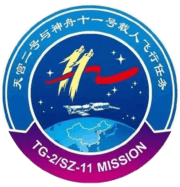Shenzhou 11
| Operator | China National Space Administration (CNSA) | ||||
|---|---|---|---|---|---|
| Mission duration | 33 days | ||||
| Spacecraft properties | |||||
| Spacecraft type | Shenzhou | ||||
| Manufacturer | CASC | ||||
| Crew | |||||
| Crew size | 2 | ||||
| Members |
Jing Haipeng Chen Dong | ||||
| Start of mission | |||||
| Launch date | 17 October 2016, 0730 China time | ||||
| Rocket | Long March 2F | ||||
| Launch site | Jiuquan LA-4/SLS | ||||
| End of mission | |||||
| Landing date | 18 November 2016 (China Time) | ||||
| Landing site | Inner Mongolia | ||||
| Orbital parameters | |||||
| Reference system | Geocentric | ||||
| Regime | Low Earth | ||||
| Docking with Tiangong-2 | |||||
| Docking date | 19 October 2016 (China time) | ||||

| |||||
Shenzhou 11 was a manned spaceflight of the Shenzhou program of China, launched on 17 October 2016 (16 October UTC) from the Jiuquan Satellite Launch Centre.[1] It is China's sixth manned space mission.[2] Two days after launch, it docked with the Tiangong-2 space laboratory, which had been launched on September 15, 2016.[1][3][4]
Crew
The crew consisted of two astronauts.[1][5]
| Position | Crew Member | |
|---|---|---|
| Commander | Jing Haipeng Third spaceflight | |
| Second crewmember | Chen Dong First spaceflight | |
The mission selected two crew instead of three to extend supplies to increase mission length for their long duration stay.[6]
Mission
The Shenzhou 11 launched at 07:30 on 17 October 2016 local time (23:30 GMT on 16 October) from the Jiuquan Satellite Launch Center using a Long March 2F launch rocket.[1]
The mission's main objective is to rendezvous and dock with the Tiangong-2 space laboratory and gain experience from a 30-day residence,[5] and to test its life-support systems.[1] The Tianzhou 1 cargo vehicle will also dock with the station to deliver supplies.
In the two days after the launch, it has changed its orbit five times to arrive 52 kilometers behind the Tiangong-2 space lab. It autonomously rendezvoused and docked with Tiangong-2 at 3:24 p.m. EDT in October 18, 2016, while both spacecraft were at an altitude of 393 km (244 mi).[4][7]
The crew landed successfully after the 33-day mission on 18 November 2016.The reentry module of the Shenzhou-11 spacecraft landed in Siziwang Banner, Inner Mongolia around 2.15 p.m(China time) after detaching from the space lab on 17 November.[8]
References
- 1 2 3 4 5 "China's Shenzhou 11 blasts off on space station mission". BBC News. 16 October 2016. Retrieved 2016-10-17.
- ↑ Perlez, Jane (16 Oct 2016). "China Astronauts to Attempt Nation's Longest Space Mission". The New York Times. Retrieved 16 Oct 2016.
- ↑ de Selding, Peter B. (20 June 2016). "China prepares assembly of its space station, invites collaboration through U.N.". Space News. Paris. Retrieved 2016-09-22.
- 1 2 "Chinese Astronauts Dock with Tiangong-2 Space Lab". 2016-10-19. Retrieved 2016-10-19.
- 1 2 Huang, Jin (8 March 2016). "Why will Shenzhou-11 carry only two astronauts to space?". People's Daily Online. Retrieved 10 March 2016.
- ↑ TMRO (19 October 2016). "Shenzhou 11 and Tiangong 2". SpacePod. TMRO.
- ↑ "China's Shenzhou-11 successfully docks with Tiangong-2 spacelab". CCTV America. 19 October 2016. Retrieved 2016-10-19.
- ↑ CNN, James Griffiths. "Shenzhou-11 astronauts return home after China's longest-ever space mission". CNN. Retrieved 2016-11-18.